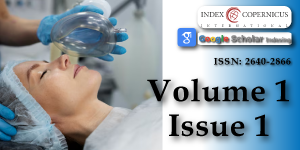Quantification of the pressures generated during insertion of an epidural needle in labouring women of varying body mass indices
Main Article Content
Abstract
Objective: The primary aim of this study was to measure pressure generated on a Tuohy needle during the epidural procedure in labouring women of varying body mass indices (BMI) with a view of utilising the data for the future development of a high fidelity epidural simulator. High-fidelity epidural simulators have a role in improving training and safety but current simulators lack a realistic experience and can be improved.
Methods: This study was approved by the National Research Ethics Service Committee South Central, Portsmouth (REC reference 11/SC/0196). After informed consent epidural needle insertion pressure was measured using a Portex 16-gauge Tuohy needle, loss-of-resistance syringe, a three-way tap, pressure transducer and a custom-designed wireless transmitter. This was performed in four groups of labouring women, stratified according to BMI kg/m2: 18-24.9; 25-34.9; 35-44.9 and >=45. One-way ANOVA was used to compare difference in needle insertion pressure between the BMI groups. A paired t-test was performed between BMI group 18-24.9 and the three other BMI groups. Ultrasound images of the lumbar spine were undertaken prior to the epidural procedure and lumbar magnetic resonance imaging (MRI) was performed within 72h post-delivery. These images will be used in the development of a high fidelity epidural simulator.
Results: The mean epidural needle insertion pressure of labouring women with BMI 18-24.9 was 461mmHg; BMI 25-34.9 was 430mmHg; BMI 35-44.9 was 415mmHg and BMI >=45 was 376mmHg, (p=0.52).
Conclusion: Although statistically insignificant, the study did show a decreasing trend of epidural insertion pressure with increasing body mass indices.
Article Details
Copyright (c) 2017 Wee MYK, et al.

This work is licensed under a Creative Commons Attribution 4.0 International License.
Royal College of Anaesthetists. Curriculum for a CCT in Anaesthetics, version 2. London. 2010. Ref.: https://goo.gl/RjbRCi
Bruce RCH, McLeod ADM, Smith GB. A survey of UK anaesthetic trainee attitudes towards simulator based training experience. Bulletin of the Royal College of Anaesthetists. 2005; 34: 1722-1723. Ref.: https://goo.gl/RM27DZ
Gaba DM. Improving Anesthesiologists’ Performance by Simulating Reality. Anesthesiology. 1992; 76: 491-494.
Zausig YA, Bayer Y, Hacke N, Sinner B, Zink W et al. Simulation as an additional tool for investigating the performance of standard operating procedures in anaesthesia. Bri J Anaesth. 2007; 99: 673-678. Ref.: https://goo.gl/HNUWNT
Kneebone RL, Nestel D, Vincent C, Darzi A. Complexity, risk and simulation in learning procedural skills. Medical Education. 2007; 41: 808-814. Ref.: https://goo.gl/GhxQXw
Vaughan N, Dubey VN, Wee MYK, Isaacs RA. A review of epidural simulators: where are we today? Med Eng Phys. 2013; 35: 1235-50. Ref.: https://goo.gl/UMiJ1R
Cook TM, Counsell D, Wildsmith JAW. Major complications of central neuraxial block: report on the Third National Audit of The Royal College of Anaesthetists. Bri J Anaesth. 2009; 102: 179-190. Ref.: https://goo.gl/XjAPnp
Paech MJ, Godkin R, Webster S. Complications of obstetric analgesia and anaesthesia: a prospective analysis of 10,995 cases. Int J Obstet Anesth. 1998; 7: 5-11. Ref.: https://goo.gl/aJTwam
Jenkins JG. Some immediate serious complications of obstetric analgesia and anaesthesia: a prospective study of 145,550 epidurals. Int J Obstet Anesth. 2005; 14: 37-42. Ref.: https://goo.gl/obXK7s
Gleeson CM, Reynolds F. Accidental dural puncture rates in the UK. Int J Obstet Anesth. 1998; 7: 242-246. Ref.: https://goo.gl/JHMRNV
Gupta S, Collis R, Harries S. Increasing dural tap rate: is this a national trend? International Journal of Obstetric Anesthesia. 2007; 16: 17.
Grantcharov TP, Reznick RK. Teaching procedural skills. BMJ. 2008; 336: 1129-1131. Ref.: https://goo.gl/sDxP7E
Smith TS, Johannsson HE, Sadler C. Trials of labour: can simulation make a difference to obstetric anaesthetic training? Current Anaesthesia and Critical Care. 2005; 16: 289-296. Ref.: https://goo.gl/57KpYd
Aggarwal R, Darzi A. Technical skills training in the 21st century. New Eng J Med. 2006; 355: 2695-2696. Ref.: https://goo.gl/HWxFq1
Bamgbade OA, Khalaf WM, Ajal O, Sharma R, Chidambaram V et al. Obstetric anaesthesia outcome in obese and non-obese parturients undergoing caesarean delivery: an observational study. Int J Obstet Anesth. 2009; 18: 221-225. Ref.: https://goo.gl/3U36u4
Perlow JH, Morgan MA. Massive maternal obesity and perioperative caesarean morbidity. Am J Obstet Gynecol. 1994; 170: 560-565. Ref.: https://goo.gl/2KYVGP
Hood DD, Dewan DM. Anesthetic and obstetric outcome in morbidly obese parturients. Anesthesiology. 1993; 79: 1210-1218. Ref.: https://goo.gl/EvgPTt
Dresner M, Brocklesby J, Bamber J. Audit of the influence of body mass index on the performance of epidural analgesia in labour and the subsequent mode of delivery. BJOG. 2006; 113: 1178-1181. Ref.: https://goo.gl/dLZzGB
Isaacs RA, Wee MYK, Dubey VN, Vaughan N. Current training in epidural analgesia: a survey of UK practice. Poster presented at Obstetric Anaesthesia 2013. Bournemouth. 2013; UK. Ref.: https://goo.gl/rGU5UT
Vaughan N, Dubey VN, Wee MYK, Isaacs RA. Towards a realistic in vitro experience of epidural Tuohy needle insertion. Proceedings of the Institute of Mechanical Engineers. Part H: J Eng Med. 2013; 227: 767-777. Ref.: https://goo.gl/t43mL2
Rodeira J, Calabuig R, Aliaga L, Espinosa W, Hobeich F et al. Mathematical analysis of epidural space location. Int J Clin Monitoring Computing. 1995; 12: 213-217. Ref.: https://goo.gl/paciJj
Tran D, Hor KW, Kamani AA, Lessoway VA, Rohling RN. Instrumentation of the loss-of-resistance technique for epidural needle insertion. IEEE Transactions of Biomedical Engineering. 2009; 56: 820-827. Ref.: https://goo.gl/wUwCwE

